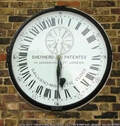
Our Creator and/or Evolution plunked mankind on earth in a universe which had already established night and day by virtue of the sun in its orbit, a solar system rotating around the sun, and the planet earth rotating on its axis within the solar system. Thus, you might say we inherited the natural cycles upon which time measurements are based: 1) the amount of time it takes the earth to complete one revolution around the sun; and 2) the amount of time it takes for the earth to make one complete turn on its axis.
But earth did not come equipped with a set of definitions, a twenty-four hour clock, time lines or date lines. All these aspects of time which we earth-dwellers are subject to, were made up … by us. Not without good reason or observation and record keeping, of course, but nonetheless created by our minds.
At first things were in a turmoil and nothing mattered to homo sapiens except the rising and setting of the sun, the weather, and surviving. It took quite a while before we took on enough of a world view to notice that if we traveled very far, something wasn’t quite right.
THE BASIC STRUCTURE OF TIME
By definition, a year is the amount of time it takes the earth to complete one revolution around the sun. A day is the time it takes for earth to complete one complete turn on its axis. But what is a day? It is just a word someone invented.
Image Credit: VectorStock
Image Source: in.pinterest.com/854698835516944858/ ▼
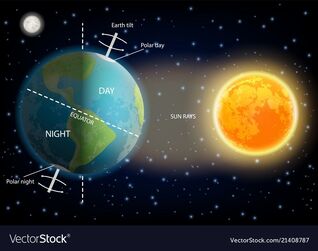
● Solar Day - The interval between the highest point of the sun in the sky on two successive days, averaged out over a year produces the normal 24 hour day.
● Sidereal Day - The time that it takes the Earth to complete one rotation on its axis so that a particular star can be observed twice at the meridian that runs directly overhead. Because the Earth is moving around the Sun as it rotates on its axis, the sidereal day is about 4 minutes shorter than the solar day, being equivalent to 23 hours, 56 minutes, and 4 seconds in mean solar time. Astronomers use a point that they call the “vernal equinox” to determine local sidereal time. There are a couple other features of time.
● Apparent Solar Time - The time based directly on the Sun's position in the sky, which in ordinary modern life runs from midnight to midnight, beginning when the sun is invisible by being 12 hours from its zenith. Astronomers use the Julian Day which runs from noon to noon for observation convenience.
● Mean solar time – This is used as the basis for local civil and standard time. The mean solar time is based on the position of a fictitious “mean sun.” The reason for this is because the Earth needs the same amount of time to turn on its axis regardless of the season while the Earth’s movement around the sun is not regular (circular) but elliptical. The earth changes its velocity and moves faster in January and slower in July, but the sun does not change its velocity, so the sun will either be ahead or behind the mean sun. This difference is called the equation of time.
ANCIENT AND NOT-SO-ANCIENT MEASUREMENTS OF TIME
Chad Orzel’s book entitled “A Brief History of Timekeeping,” tells us that humans have been recording time and keeping track of their passing hours since Neolithic times. Water clocks and sundials were first ancient timepieces.
| Qumran - Mesopotamia - 200 B.C. ImageSource:downunderpharaoh.patternbyetsy.com/sundial | Modern clepsydra |
Image Source: downunderpharaoh.patternbyetsy.com/sundial
GREENWICH MEAN TIME
In 1675, the British Royal Observatory established what is called Greenwich Mean Time. The purpose established this set time to assist mariners in navigating at sea, even though they had become pretty good at it with the instruments available. This is also called the Prime Meridian, a planet's meridian adopted as the zero of longitude.
Before this, the time of day was calculated with a sun dial using solar time. This time would be different for every location but gave an accurate representation of the local time depending on where exactly in the world the sundial was being used.
THE INTERNATIONAL DATE LINE
Once mechanical clocks and watches began gaining in popularity during the early 19th century, more activity occurred to increase in time standardization, including the a meeting of the International Meridian Conference.
The International Date Line (IDL) serves as the "line of demarcation" between two consecutive calendar dates. It was created in 1884 by the International Meridian Conference as an imaginary line which follows, roughly, the 180° meridian (and not any other meridian including the Prime Meridian) from North- to South-Pole, with a few zigzags around political boundaries.
The delegates at this conference, attended by 26 nations, decided on the 180° meridian based on its location. Because it divides one day from the next, it made sense to run the imaginary line through open seas (Pacific Ocean) to create as much space and time between land masses for minimum confusion. It does vary in places to keep surrounding nations, which are primarily island countries, within the same day and date.
As odd as it may seem, the International Date Line has no legal international status. Countries are free to choose the dates that they want to observe.
Image Source: maritimeprofessional.com/blogs/international-date-line
Another surprising fact in this day and age, is the ease of shifting the date line. The country wanting the change can decide for itself. It’s simply a matter of publicizing the event and informing the international community and map-makers. The figure below shows the difference between the IDL.
Image Credit: Shutterstock/Nasky)
Image Source: livescience.com/44292-international
Along with the International Date Line, the 1884 Conference also established a system of standard time: Time Zones.
Going back to Solar Mean Time, if all the clocks on earth were set by mean solar time, they would all be “technically correct” in their own locations, but telling time and traveling would be unmanageable. This was the situation until 1884 Conference took action.
A few years before that, in 1876, the first system of time zones was conceived by Sir Sandford Fleming, a Scottish engineer who helped design the Canadian railway system. He felt the system would make the railroad more efficient and avoid complications resulting from the different schedules set by the different train stations, which set the time according to their local astronomical conditions. His proposal, which was put into effect by the railroad companies of Canada and the U.S., ended some 100 conflicting local sun times observed in terminals across the land.
The system adopted at the Conference divided Earth's surface into 24 zones. The standard time of each zone is the mean astronomical time of one of 24 meridians, 15 degrees apart, beginning at the Greenwich, England, meridian and extending east and west around the globe to the International Date Line. For practical purposes, variations occur.
Image Credit:: CIA, 2018, public domain.
Image Source: geographyrealm.com/geography-time-zones/
In Antarctica there are no inhabitants except the staffing of the research stations. For practical purposes, time zones are usually based on territorial claims; however, many stations use the time of the country they are owned by or the time zone of their supply base (e.g., the American stations McMurdo and Amundsen–Scott (South Pole Station) use New Zealand time due to their main supply base being Christchurch, New Zealand).
There is no procedure or approval process for a country to change it’s time zone, other than to notify appropriate entities of the change. In the United States time zones can be changed only by Congressional Statute or by regulation of the Secretary of Transportation.

Daylight Saving Time always takes most of us by surprise when it occurs twice a year, and the older I get, the harder it is to adjust. But anyone reading this understands how the system works. No need to repeat. “Spring Forward” one hour! Get used to the hours. Then “Fall Back” one hour. And so on.
Western nations were the first to adopt Daylight Saving Time. In April, 1916 Austria and Germany adopted Daylight Saving Time as a wartime measure to conserve electricity. Other countries in Europe followed suit, including Britain.
● In The United States
The U.S. accepted the idea in March 1918, as a wartime measure, not for the benefit of farmers, as some people believe. After the war ended, President Woodrow Wilson ceded to popular demand and repealed Daylight Saving in the U.S. When WWII came along, President Roosevelt (FDR) mandated the measure, known as "War Time", throughout the United States in 1942.
This time, it stuck for most of the country but for years, different cities and states in the U.S. started and ended their daylight saving time on different dates, creating chaos throughout the country. Congress passed a law in 1966 which set a standard for Daylight Saving Time with the period beginning on the last Sunday in April and ending on the last Sunday in October. The law gave the states the option of remaining on standard time year round. Since then, the October date has been moved to November, so this year, 2022, the “fall back” time change happens on November 6.
● In The Rest Of The World
Not all countries in the world have accepted the practice of Daylight Saving Time, or DST.
Areas of Africa and Asia don’t observe DST and areas of South and Central America and Oceania are mixed.
New Zealand and Southern Australia practice Daylight Saving Time while the rest of Australia does not. In South America the countries of Chile, Paraguay, Uruguay and parts of southern Brazil practice Daylight Saving time while places north of the continent of South America typically do not. Russia, across its many (ten!) time zones also has DST in place.
Image Source: geographyrealm.com/daylight-saving-time/
TAKE AWAYS
Time, in the sense of accounting for it, is imaginary. In reality, NOW is always one step into the future.
Mankind’s grasp of the abstract essence of time is quite remarkable. From ancient times, humans understood its importance even without understanding the scientific mechanisms and, with great ingenuity, devised ways of measuring it in relation to the patterns of movement of the earth and sun.
JUST SAYIN’!
□
Sources:
https://www.maritimeprofessional.com/blogs/post/international-date-line-13350
https://en.wikipedia.org/wiki/International_Date_Line
https://commons.wikimedia.org/wiki/File:International_Date_Line.png
https://www.geographyrealm.com/geography-time-zones/
https://www.geographyrealm.com/geography-daylight-saving-time/
https://www.timeanddate.com/time/current-number-time-zones.html
https://www.livescience.com/44292-international-date-line-explained.html
https://in.pinterest.com/pin/854698835516944858/
https://oceanservice.noaa.gov/facts/international-date-line.html
https://greekreporter.com/2022/02/09/ancient-greeks-measured-time/
https://www.bbc.com/news/world-13334229
https://www.infoplease.com/calendars/months-seasons/time-measurement-time-zones-and-international-date-line
https://downunderpharaoh.patternbyetsy.com/listing/501693398/sundial-calendar-mesopotamia-ancient
https://www.cbc.ca/news/world/five-facts-about-the-international-date-line-1.1023240#:~:text=The%20date%20line%20shown%20on%20most%20maps%20is,it%20is%20not%20recognized%20as%20a%20legal%20entity.
https://www.geographyrealm.com/geography-of-the-international-date-line/#:~:text=The%20International%20Date%20Line%20was%20conceived%20of%20in,the%20world%20began%20becoming%20more%20and%20more%20globalized
https://www.timeanddate.com/time/dateline.html#:~:text=The%20International%20Date%20Line%20%28IDL%29%20is%20located%20at,and%20marks%20the%20Western%20and%20Eastern%20Hemisphere
https://sites.google.com/a/notredameacademy.com/greek-world-history-project-spring-2017/achievements-and-advancements/ancient-greek-inventors
https://www.transportation.gov/regulations/procedure-moving-area-one-time-zone-another#:~:text=Under%20Federal%20law%2C%20there%20are%20two%20ways%20in,Secretary%20of%20Transportation%20may%20issue%20regulations%20making%20changes.
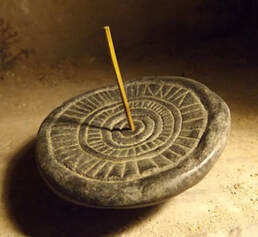


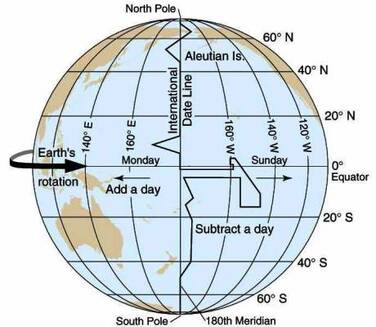
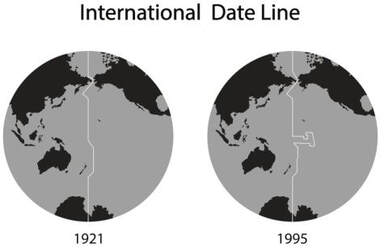
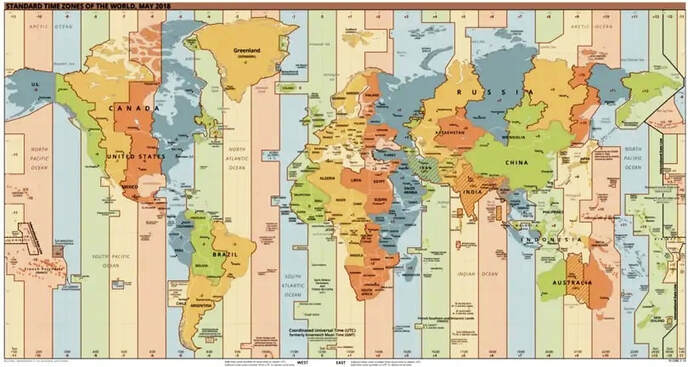

 RSS Feed
RSS Feed